This was published 1 year ago
The future of aviation: What air travel will look like over the next 15 years

The Airbus A321XLR has a range of 8700 km.Credit: AIRBUS
What does the next 15 years hold for air travel? Will drones transport us from the airport to the city? Will we be loaded into detachable pods at the terminal which then plonk into place on the aircraft? Or sit stacked above other passengers to make use of that overhead space?
Probably none of the above, but here's a few new aviation experiences that definitely lie just over the horizon. Let's start with the nuts and bolts with some exciting new aircraft that will soon be appearing in our skies.
LONGER, FASTER, SMOOTHER

The single-aisle Airbus A321XLR is the latest iteration of Airbus' popular A320 family, and it's a game changer. With a range of 8700 kilometres, no other narrow-body commercial aircraft even comes close.
Boeing's 737 MAX 9, the latest version of the most popular commercial aircraft ever, has a range of 6570 kilometres while the figure for the MAX10, expected to enter service in 2023, is 6110 kilometres. The A321XLR could fly from Melbourne to Tokyo non-stop, or Brisbane to Honolulu.
In the northern hemisphere, that range would take the A321XLR non-stop between London and Vancouver, Tokyo and San Francisco, New York and Istanbul and New Delhi and London.
That's a big selling point since the A321XLR allows airlines to operate narrow-body aircraft on long-distance, lower demand routes where a twin-aisle aircraft may not be economical. Qantas has placed an initial order of 20 A321XLRs with an option to buy more to replace its fleet of Boeing 737s and 717s.
What about supersonic flight? Wouldn't we love to have supersonic aircraft flying into and out of Australia? Mach 2 flights would take us from Sydney or Melbourne to Europe in less than 12 hours, to the west coast of the US in under seven.
Denver-based Boom Technology is the most advanced of several manufacturers developing supersonic aircraft. Boom's Overture is a four-engine, 65 to 80 seat delta wing aircraft with a range of 7867 kilometres which the company hopes to have carrying passengers in 2029.
But there are hurdles to overcome, including the requirement to fly at subsonic speeds over land, the limited passenger numbers carried aboard these pencil-thin aircraft and the high fuel consumption and carbon emissions they generate at high altitude. That puts supersonic aircraft out of step with an industry eager to demonstrate its eco-credibility, and a world that demands it.
TOWARDS A FUELS PARADISE
The commercial aviation industry is under immense pressure to do its bit to limit its carbon emissions. Qantas chief executive Alan Joyce has plans for the airline to achieve zero carbon emissions by 2050, with a 25 per cent reduction by 2030.
But the only way to achieve that is by powering aircraft with something other than petroleum-based fuel. Sustainably produced aviation biofuel is one alternative but biofuels are neither cheap nor available in the quantity required for a major shift in the aviation industry's carbon footprint.
Hydrogen, however, is abundant, and burning hydrogen fuel in a jet aircraft engine would produce zero carbon emissions. One way of producing hydrogen is electrolysis, which requires electricity, and if that electricity comes from sustainable sources such as wind or solar the aviation industry is well on the way to achieving near-zero emissions.
However a huge volume of hydrogen gas is needed to deliver energy equivalent to conventional aviation fuel, and that rules out hydrogen gas as a jet fuel source. Cooling hydrogen to -253°C it becomes a liquid, massively increasing its energy density, and it becomes a feasible jet engine fuel.
That requires a special fuel tank, which is why we won't be seeing hydrogen-powered commercial aircraft for some time. Airbus is hoping to have the world's first hydrogen-powered commercial aircraft in the air by 2035.
THE HEAT IS ON, AND ON
Climate change has hit Europe hard this summer and it's affected flights. Soaring temperatures caused the surface to lift at Luton Airport, leading airport authorities to reconsider the way they build runways. And since lift decreases as temperatures rise, aircraft need more runway to get airborne.
Across Portugal, Spain, Italy and Greece, wildfires provided beach scenes with doomsday backdrops. In early May I was swimming in warm water in Sicily while Rome was uncomfortably hot towards the end of the month. Some are rethinking their European holidays, with a tilt away from Mediterranean Europe in favour of the Baltic.
Copenhagen instead of Rome, a Norwegian cruise instead of the Mediterranean. This summer's heat wave was probably not a one-off. Anyone planning a European holiday in future might do well to avoid the Mediterranean in the hottest months of mid-June to late August.
A JUMBO-SIZED CHALLENGE

Credit: AP
Boeing's 777X is being touted as the ideal replacement for the much-loved 747, and possibly the Airbus A380 as well. In typical configuration, the twin-engine giant carries 426 passengers, about the same as a Boeing 747, although more than a hundred fewer than the A380 in a comfortable three-class configuration.
Crucially, its engines burn less fuel and the 777X's range of 15,185 kilometres makes it an ideal candidate for airlines looking for an aircraft for busy intercontinental routes. Qantas was expected to be an early customer but the airline has opted for Airbus A350s and Dreamliners.
It's likely that Australia will see the 777X in the next few years wearing the livery of the Middle East and Asian carriers. Emirates has ordered 115, Qatar Airways 74 and Etihad 25, and Singapore Airlines, Cathay Pacific and ANA are all on board. British Airways and Lufthansa are the sole European customers, while no US carriers have signed up.
Originally planned to enter commercial service in 2019, the 777X has been plagued by delays. In May 2021 the Federal Aviation Administration informed Boeing that the aircraft would not be certified until mid-to-late 2023. Boeing has pushed back the first deliveries to 2025.
ONE OF MANY GIANT LEAPS
Coming soon, non-stop flights from east coast Australia to the UK and New York. The Qantas Project Sunrise flights have been a trophy-case dream for the Qantas chief executive for several years now.
The giant leap from Melbourne or Sydney to London requires a new aircraft type other than the Boeing 787-9 Dreamliners the airline uses on its non-stop flights between Perth and London and Qantas has confirmed an order for 12 modified Airbus A350-1000 aircraft.
With a flight time of around 20 hours, the east-coast Australia to London flight will be the world's longest, representing a test for the endurance of economy-class flyers. In the meantime, Air New Zealand will begin its own non-stop flights between Auckland and New York, scheduled to commence on September 17, 2022.
In another first, and a handy concession to economy flyers on agonisingly long flights, the airline is proposing to offer sleeper beds to economy flyers. Known as Skynest, the bunk-style sleepers will be bookable in four-hour blocks on Air NZ's Boeing 787-9 Dreamliners, starting in 2024.
BONZA GAMBLES ON A BONANZA

Australia's aviation industry will soon see a fresh face when low-cost carrier Bonza begins flights, possibly as early as September 2022. Rather than going head-to-head with Qantas and Virgin Australia on the popular east coast trunk routes, Bonza plans to operate 25 routes across 17 regional locations such as Albury, Bundaberg, Coffs Harbour, Mildura, Newcastle and Port Macquarie. Melbourne is also on the list, but not Sydney.
From its home base on Queensland's Sunshine Coast, the all-economy airline will be making a play for the leisure market, with prices comparable to Jetstar's.
Eighty percent of its proposed routes, according to Bonza chief executive Tim Jordan, are not presently served, while all but four have no low-cost airline on the route. Bonza's all-Boeing 737 fleet will be funded by US investment firm 777 Partners, which already has a presence in the low-cost aviation industry with Canadian carrier Flair Airlines.
FIVE AIRLINE FIXES FOR THE NEXT 15 YEARS
CONSUMER PROTECTION
If you have a beef with an Australian airline, the referee is the Airline Customer Advocate which was set up by and is financed by the airlines, and it's a complete joke. What's needed is an independent, government-appointed arbiter.
COMPENSATION
In Europe, flyers are entitled to compensation if their flight arrives at its final destination more than three hours behind schedule. So too if your flight was cancelled with less than 14 days notice.
FLIP-UP ECONOMY SEATS
How much easier would it be for window-seat passengers to access their seats if the seat bottoms flipped up? Passengers in the same row could simply stand and let them pass, as it is they usually have to exit the row to let them by.
MORE BANDWIDTH FOR INFLIGHT WIFI
Several international carriers that serve Australian ports offer global coverage but data speeds can crawl if multiple users log in. The Ka-band satellite broadband used by some airlines including United and British Airways is the gold standard.
A FAIR SEAT FOR A FAIR PRICE
A premium economy seat costs at least twice as much as an economy seat, yet it only offers around 120cm more legroom and slightly greater recline angle. How about an economy seat that offers 50 per cent more legroom for a fare 50 per cent above economy? I'd pay that and the airline gets the same revenue per square centimetre.
Sign up for the Traveller newsletter
The latest travel news, tips and inspiration delivered to your inbox. Sign up now.